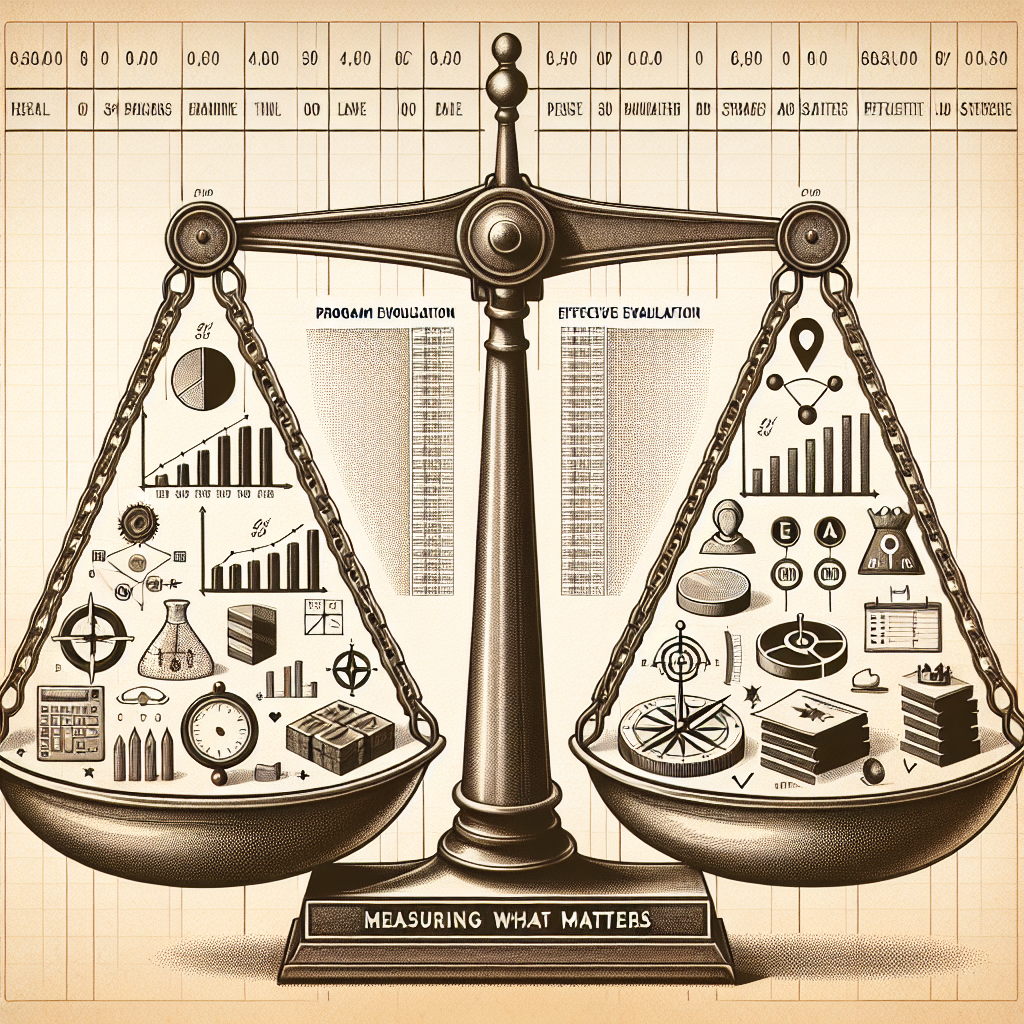
Introduction
In a world where resources are finite and expectations are high, the ability to measure the effectiveness of programs has never been more critical. Measuring what matters is not just a buzzword but the key to driving success and ensuring accountability in various sectors, from education to nonprofit organizations. The importance of effective program evaluation cannot be overstated; it directly impacts decision-making, funding allocations, and overall program improvement.
This article will delve into the Measuring What Matters: Key Strategies for Effective Program Evaluation, providing actionable insights that organizations can utilize to enhance their evaluative processes.
The Importance of Evaluation: Why It Matters
Before we dive deeper, let’s explore why measuring what matters is essential. Evaluation serves multiple purposes:
- Accountability: Stakeholders want to know if their investments yield results.
- Improvement: Evaluative measures help identify strengths and weaknesses, enhancing program performance.
- Decision-Making: Solid evidence informs policy-making and resource allocation.
Understanding these facets is crucial in grasping the significance of program evaluation.
Key Strategies for Effective Program Evaluation
1. Clarifying Goals and Objectives
An effective evaluation starts with clear goals. The first step in Measuring What Matters effectively is aligning your goals with measurable objectives.
Example Case Study: The Education Sector
A nonprofit organization aimed to improve literacy rates among children ages 6 to 12. They started by clearly defining their goals:
- Increase reading proficiency by 20% in one school year.
- Improve parental engagement by creating reading clubs.
Their evaluation approach focused on these specific objectives, making it easier to track progress.
2. Utilizing the Right Frameworks
Adopting established evaluation frameworks aids in standardizing measurements and approaches. Commonly used frameworks include Logic Models and Theory of Change.
| Framework | Description |
|---|---|
| Logic Model | Visual representation showing inputs, outputs, outcomes, and impacts. |
| Theory of Change | Outlines the assumptions behind program activities and intended outcomes. |
Example Case Study: Health Programs
A health initiative aimed at reducing obesity rates in teens used the Logic Model framework to map out their inputs (resources), activities (workshops), outputs (number of workshops conducted), and short- to long-term outcomes (weight loss percentages).
3. Collecting Data Effectively
Data collection is fundamental to Measuring What Matters. Decide on qualitative versus quantitative data based on your evaluation needs.
| Data Type | Methods | Pros | Cons |
|---|---|---|---|
| Qualitative | Interviews, focus groups | In-depth insights | Time-consuming to analyze |
| Quantitative | Surveys, statistics | Easier to analyze quickly, shows trends | May lack depth in understanding context |
Example Case Study: Community Programs
A community art program utilized both qualitative methods (interviews with participants) and quantitative methods (surveys measuring engagement levels). This hybrid approach provided a fuller picture of the program’s success.
4. Engaging Stakeholders
Involving stakeholders in the evaluation process promotes accountability and ownership.
- Assessing Needs: Jointly identify issues to evaluate.
- Reporting Findings: Share results transparently.
Example Case Study: Environmental Initiatives
A local environmental group engaged community members in assessing the impact of a recycling program. By incorporating feedback, they refined their initiatives, leading to a notable increase in participation rates.
5. Iterative Evaluations
Conducting evaluations iteratively allows for adjustments in real-time. Instead of waiting until the end of a program, ongoing evaluations help identify areas needing immediate improvement.
Example Case Study: Corporate Training
A corporate training program utilized iterative evaluations by collecting feedback after each session. This adaptive process led to increased satisfaction rates and improvements in training content.
6. Communicating Results
No evaluation is complete without effective communication of results. Use clear, concise language and visuals to convey findings.
| Communication Method | Audience | Purpose |
|---|---|---|
| Reports | Internal stakeholders | Detailed analysis and recommendations |
| Infographics | General public, donors | To summarize findings visually |
Example Case Study: Nonprofit Organizations
A nonprofit aimed at homelessness created infographics to showcase the impact of their initiatives. This method successfully captured the attention of donors and stakeholders, increasing funding opportunities.
7. Learning Culture
Fostering a learning culture promotes continuous improvement, making it easier to adapt based on evaluative findings.
Example Case Study: Educational Institutions
A university implemented an institutional evaluation system that encouraged faculty to iterate their curriculum based on student feedback. The results showed increased student satisfaction and graduation rates.
Conclusion
In conclusion, measuring what matters is critical for any program to thrive. The Key Strategies for Effective Program Evaluation discussed here, from clarifying goals to fostering a learning culture, provide a robust framework for organizations looking to drive impactful change.
Actionable Takeaway
Embrace a systematic, adaptable approach to evaluation in your organization. Remember, effective program evaluation isn’t just about tracking numbers; it’s about understanding stories behind those numbers to enact meaningful change.
Frequently Asked Questions (FAQs)
1. What is program evaluation?
Program evaluation is a systematic method of collecting, analyzing, and using information to answer questions about a program’s effectiveness.
2. How often should program evaluations take place?
The frequency of evaluations can vary depending on the program’s complexity and the resources available. However, iterative evaluations can provide timely insights for continuous improvement.
3. What tools are available for program evaluation?
Several tools are available, ranging from survey platforms like SurveyMonkey to data visualization tools like Tableau.
4. Can small organizations implement effective evaluations?
Absolutely! Even with limited resources, smaller organizations can apply the same principles of clarity, stakeholder engagement, and iterative evaluations to measure their effectiveness.
5. What are common challenges in program evaluation?
Some challenges include inadequate resources, lack of stakeholder buy-in, and difficulties in data collection. Addressing these can lead to a more effective evaluation process.
By focusing on Measuring What Matters: Key Strategies for Effective Program Evaluation, your organization can harness the power of evaluation to achieve greater success and accountability.

















